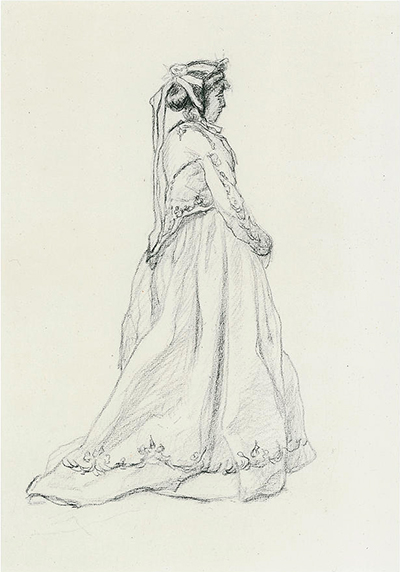Of course, several of his sketches were preliminary studies or idle doodles, but many of them are works of art in and of themselves.
The drawing called 'Figure of a Woman' is a work of art that falls into this last category - using charcoal on regular whitish paper, it shows us a woman in a sweeping dress and bonnet, with her body turned so that she is in profile.
Though Figure of a Woman is a black and white work of art, it may remind us of other more colourful works of art created by Monet which also depicted the figure of a single woman with attention paid to her garments. One example is his oil on canvas painting called Woman with a Parasol, for example.
The way in which this figure is turned around in this drawing is interesting - she is not turned to face us in the way that we might expect from a traditional portrait. Instead, she turns away and seems to be looking at something to the side of the paper, lost in her own world.
Thus, though the quality of the draughtsmanship draws the viewer's eyes in as they look at this sketch, the woman's attitude seems to push the viewer slightly away. Or, at least, the woman does not give away much about herself, it could be argued.
There is a sense that this sketch was created quickly - like many of Monet's works it is very dynamic. Though he is especially famous for his series of paintings of natural features - the Waterlilies series is perhaps the most iconic example - Monet did paint a large body of work that depicted female figures.
Alongside the painting of the Woman with a Parasol described above, he also painted a cherished work called Woman in a Green Dress. Many of his figures are facing slightly askance - the woman with the parasol is depicted by him both facing right and facing left in two separate works, for example. However, they are rarely depicted in total profile, as the woman is in this drawing.
This drawing is less impressionistic than Monet's earlier works. In fact, it could be described as a realistic work of art - though without colour, its use of form creates a very real image of the woman. The term Impressionism was not coined until 1874 when Monet released his painting called Impression, Soleil Levant (Impression, Rising Sun) and the name stuck.
He is now known as one of the world's most famous and accomplished Expressionist artists. In its medium, unconventional for Monet who came to work primarily in oils, and in its black and white realistic execution, Figure of a Woman stands out in an interesting manner.


